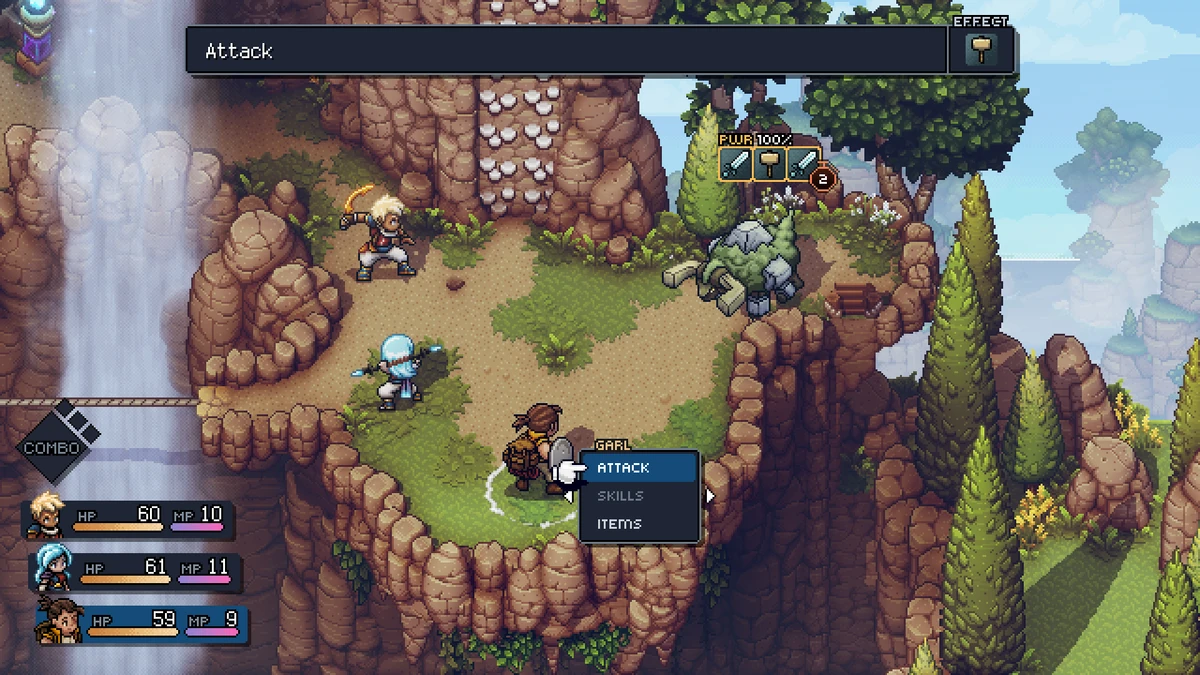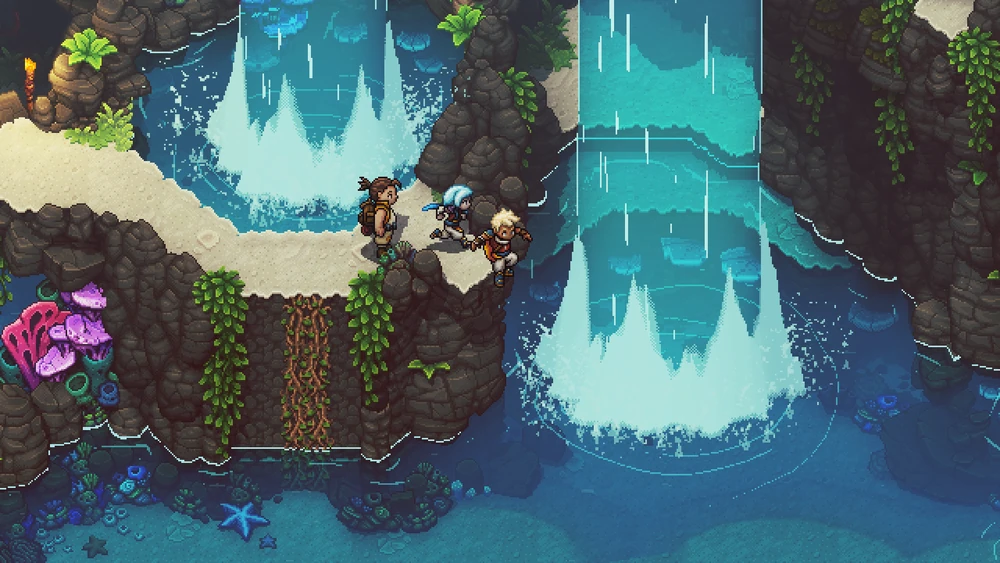Search
[{{{type}}}] {{{reason}}}
{{/data.error.root_cause}}{{{_source.title}}} {{#_source.showPrice}} {{{_source.displayPrice}}} {{/_source.showPrice}}
{{#_source.showLink}} {{/_source.showLink}} {{#_source.showDate}}{{{_source.displayDate}}}
{{/_source.showDate}}{{{_source.description}}}
{{#_source.additionalInfo}}{{#_source.additionalFields}} {{#title}} {{{label}}}: {{{title}}} {{/title}} {{/_source.additionalFields}}
{{/_source.additionalInfo}}Sea of Stars (PC)

Sea of Stars
Developed By: Sabotage Studios
Published By: Sabotage Studios
Released: August 29, 2023
Available On: PlayStation 4, PlayStation 5, Xbox One, Xbox Series X/S, Nintendo Switch, Windows
Genre: RPG, Adventure
ESRB Rating: E10+: Fantasy Violence, Mild Blood, Mild Language
Number of Players: 1 offline
Price: $34.99
Sea of Stars is a recently released turn-based RPG that has often been referred to as a true spiritual successor to Chrono Trigger. Sabotage Studio, the developer of Sea of Stars, first came onto the game scene in 2018 with the release of The Messenger, a retro 8/16-bit sidescroller in the vein of Ninja Gaiden. Received almost instantly as a great homage to a classic genre, many people found themselves anxiously awaiting their next project. In 2020, they announced Sea of Stars on Kickstarter as both a successor to classic RPG titles of the 16-bit era and a prequel to their previous hit The Messenger, and reached their funding goal in a single day. Later, they even managed to get Chrono Trigger composer Yasunori Mitsuda to join the project. With so much hype building, and so much riding on the final product, did Sabotage deliver in the end? I’d happily say so, but with a small caveat. Let’s dive in. In Sea of Stars, you play as Zale and Valere, two children who have the ability of Eclipse Magic, giving them each power over Solar and Lunar magic, respectively. The children want to become Solstice Warriors; skilled adventurers who go out into the world to defeat “Dwellers”, which are horrifying monsters and creations of the evil Fleshmancer, the infamous alchemist who has long plagued the land with his creatures. They grow up alongside their childhood friend Garl, a mischievous pal who may not be a wizard, but is still a wiz in the kitchen. The trio pledge to each other that once the children become Solstice Warriors, they’d travel the world together, fighting evil as one. Inspired by the strength of their heroes and current Solstice Warriors, Brugraves and Erlina, the two children eventually pester the elderly instructor Moirane to begin training them. Here, the children are told to continue honing their innate magic, and after a process that takes years finally begin their adventures with their friend Garl (proclaimed the Warrior Cook). Sea of Stars reminds me of RPGs I played long ago that were aimed at children or young teens, such as the Paper Mario and Mario & Luigi series, in that they balance more mature settings and themes with E-rated dialogue and characters. It is written somewhere in-between modern simplified storylines and the complicated masterpieces of the past; though I do at times wish it tended towards the latter, as some arcs or moments of conflict simply resolve without much reason, leaving me unsatisfied.

Strong Points: Great gameplay loop; beautiful art; incredible soundtrack and sound design
Weak Points: At times poor writing; tries too hard to be connected to its sequel, The Messenger
Moral Warnings: Occasional language; some blood and RPG violence; necromancy; alchemy; human sacrifices; references to gods and goddesses
In Sea of Stars, you can have three members in a party against a variable number of enemies. Combat primarily centers around turns, magic, spell-breaking, timed hits/blocks, boosting, and combos. All enemies have an hourglass above them showing when their next attack will be unleashed, and no enemy attacks before all three characters have attacked. If you take too much damage and your character passes out, you have to wait between 1-3 turns for them to return with a portion of their health. There are four different types of magic, as well as two physical damage types: Sun, Moon, Poison, Arcane, Sword, and Blunt. Many enemies have weaknesses and resistances to certain things, and attacking them with the element they are vulnerable to will deal extra damage, while attacking with a resistant element will deal less damage. Sometimes enemies will use special attacks that can be broken by doing magic and/or physical attacks, such as two Sword damage and three Moon damage. Timed hits/blocks involve pressing the action button at a precise moment, which will do extra damage if attacking and minimize damage if blocking. Some special magic/physical attacks can even be kept going by continuing to press the action button, similar to Bros. Attacks from the Mario & Luigi series. When you perform a non-Skill attack, you generate something called Live Mana. You can use Live Mana to boost your normal attacks by adding a magic enchantment to them (except for poor Garl). This can help balance the spell-breaking mechanic, but using a boosted normal attack will not generate more Live Mana. There’s also the traditional MP system in the form of Skills, which are more powerful attacks all characters can perform. Doing any kind of normal attack will regain 3 MP. And finally, as you attack and block, you will generate combo points that can be used to perform combo attacks between two characters. There are just over a dozen combo attacks that involve all the types of magic and physical elements, as well as some combos that can restore health. With so many complex and fun mechanics, it’s no surprise that the game easily kept me wholly entertained for almost 30 hours. It was a rich experience that reminded me of the RPGs I played as a child, and I can say with absolute certainty that the core gameplay loop is Sea of Stars’ second-strongest component. “Now hold on just a moment; second-strongest component? Even after all of that?” Yes. Because the true elegance and brilliance of Sea of Stars lies in its fantastic visuals. There are times I have had to stop myself just to stare at the art–questioning if it was just a 3D model with some filters applied. But it isn’t. Nearly every single beautiful, detailed background, sprite, and object are all fluidly animated in pure pixels. It is no stretch to say this may be the best pixel art in a game since the Golden Age of the 16-bit era, and perhaps of all time. Beyond their incredible work on the art, Sabotage has developed an amazing dynamic lighting system that allows you to change the time of day, casting long shadows off the pixel art and reacting to light coming from the world, your characters, and other sources. I praised Outer Wilds for a similar mechanic, as true dynamic lighting in games is possibly my favorite technique that is rarely used due to its expense, but Sabotage in my opinion deserves even more credit for managing to pull this off flawlessly in an isometric world with pixel art, and not 3D models. As evening shifts to night, the color palette of the world will cool down, and as it turns to morning it will warm again. All times of day adjust the colors slightly, giving you a true feeling of a living, breathing world.

Higher is better
(10/10 is perfect)
Game Score - 90%
Gameplay - 16/20
Graphics - 10/10
Sound - 9/10
Stability - 5/5
Controls - 5/5
Morality Score - 63%
Violence - 3.5/10
Language - 7/10
Sexual Content - 10/10
Occult/Supernatural - 2/10
Cultural/Moral/Ethical - 10/10
The music also gives me great joy, as it is strongly inspired by the soundfonts of SNES games. But beyond the nostalgia of the olden days, the music is truly well-composed and blends modern soundscapes with old in a perfect combination. Although some tracks weren’t my favorite, each track provides a strong ambiance to each new area that allows you to become engrossed in the experience. Beyond the music, the sound design is superb. Every sound effect is high quality and extremely pleasing to the ears; fine-tuned to be a great balance between sharp cuts and slashes, the deep pounds of a staff or shield, the whirling wind of flames, and so on. All of the sounds come together as if they were designed to be satisfying—like those ASMR compilations you never click on but always hear people enjoy—that’s Sea of Stars to me. Now whether that is a good or bad thing I leave to you to determine, but overall, I think it’s quite rad. Before we move on to the morals section, I do have to say one thing that leaves me dissatisfied with Sea of Stars. I said at the start of this review that it is a prequel to The Messenger, and Sabotage really want you to know this is a prequel. There are a lot of questions, places, or entities that are left unresolved or unexplained, and I have discovered after beating the game that this is due to connections with its sequel. The most egregious example being the final closing credits sequence of the game slowly panning to reveal a location that has no importance unless you have played the sequel, which confused me as to the significance during my playthrough. While that is all well and good, it leaves Sea of Stars feeling partially like an incomplete narrative as a lot of things just end up pointing you towards The Messenger, which I believe is a poor move, especially since the two games are nothing like each other genre-wise. I am hoping that the upcoming DLC will bridge some of the gap between the two games (which, mind you, are canonically thousands of years apart) and try to explain why some of these questions were left unresolved. Morally, the game is a bit muddied. There are references to “Guardian Gods”, and even talk of ascending to such a status. There are several examples of necromancy, as well as reconstructing people into flesh monsters or machines. There are references to eternal curses and alchemy that require sacrifices. There is blood present in the game. Characters occasionally use mild language like d##ned, b###ard, and so on. Surprisingly, there is little to no suggestive content present in the game. Overall, Sea of Stars is an incredible effort that exists both as a love letter to classic RPGs and a movement towards a true modern formula with its amazing gameplay, pixel art, and sound design. I only hope that in their future attempts, they will put a bit more care into the narrative and move away from The Messenger’s connections.








